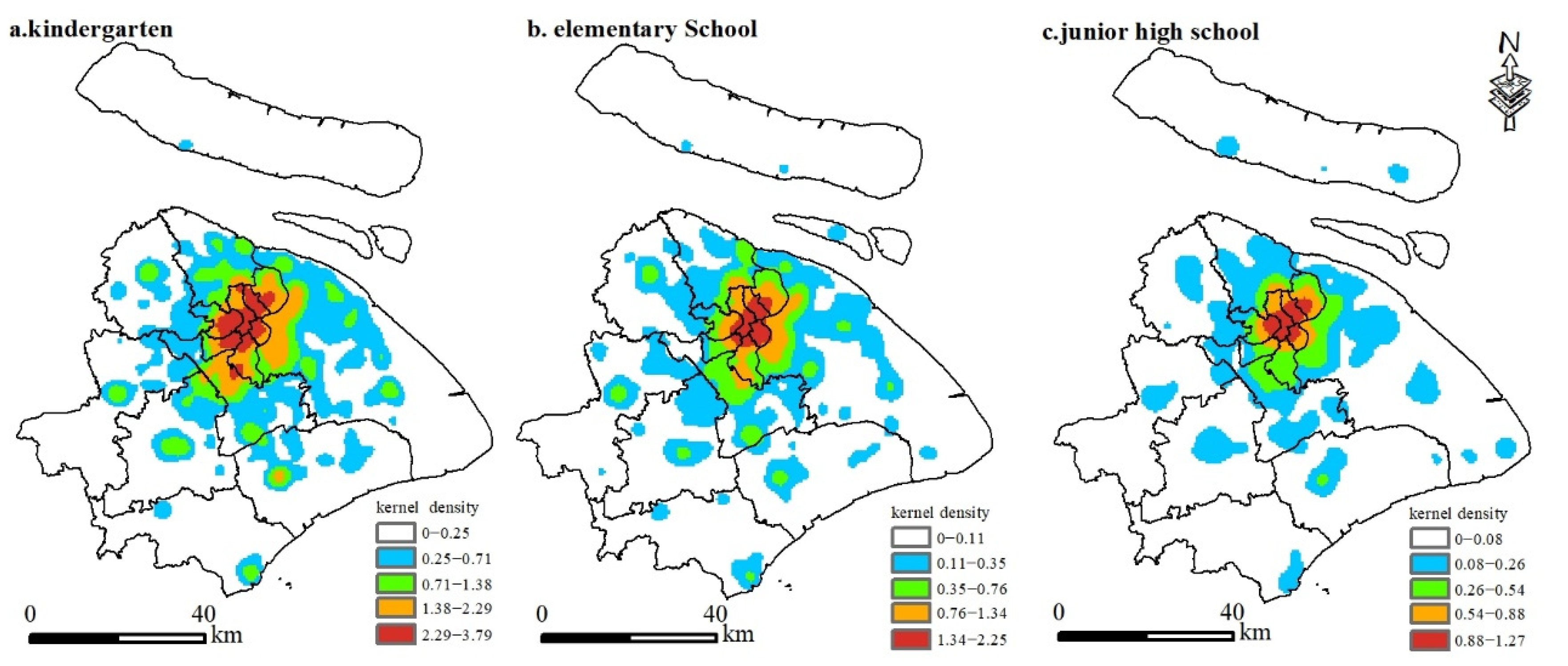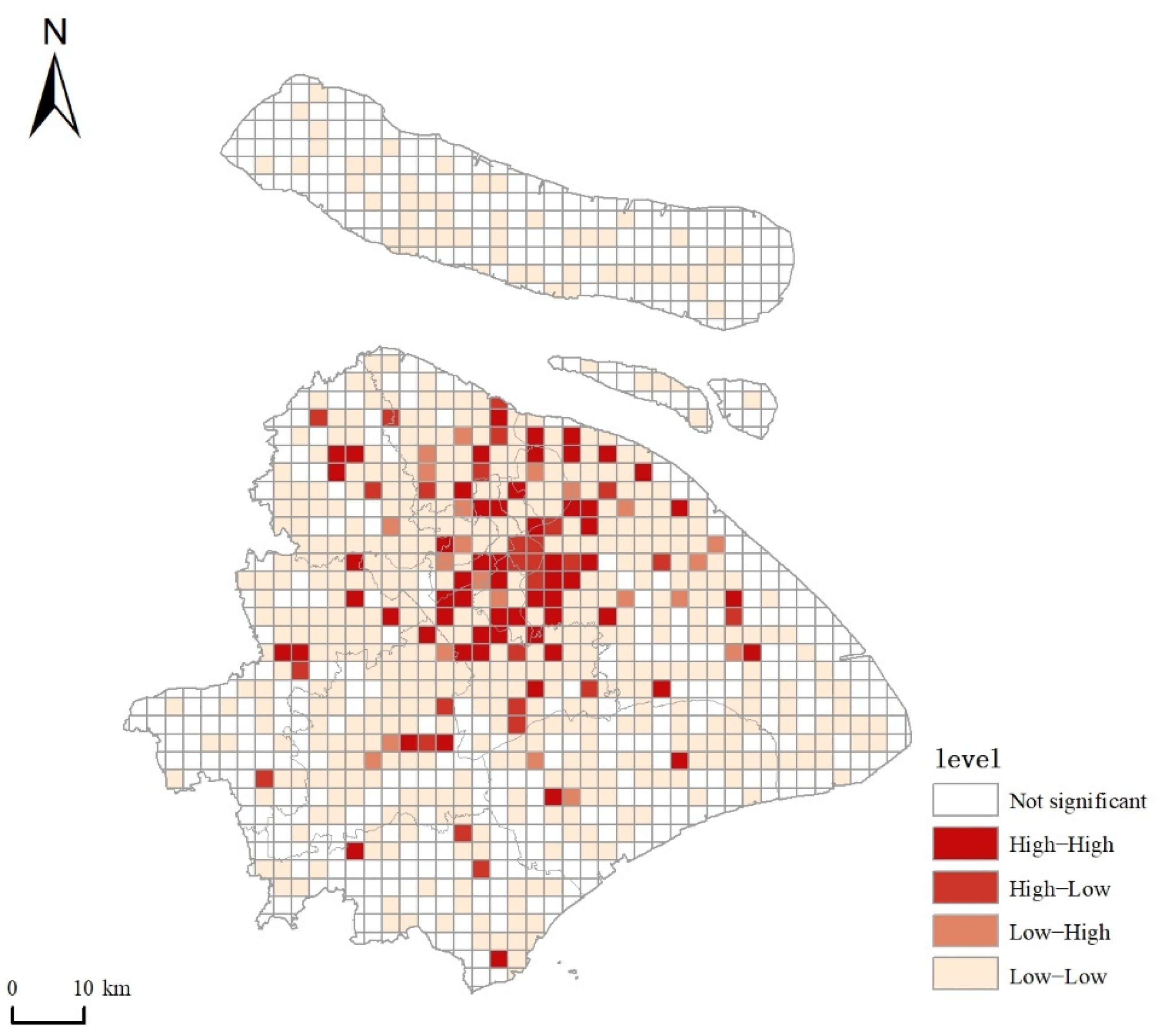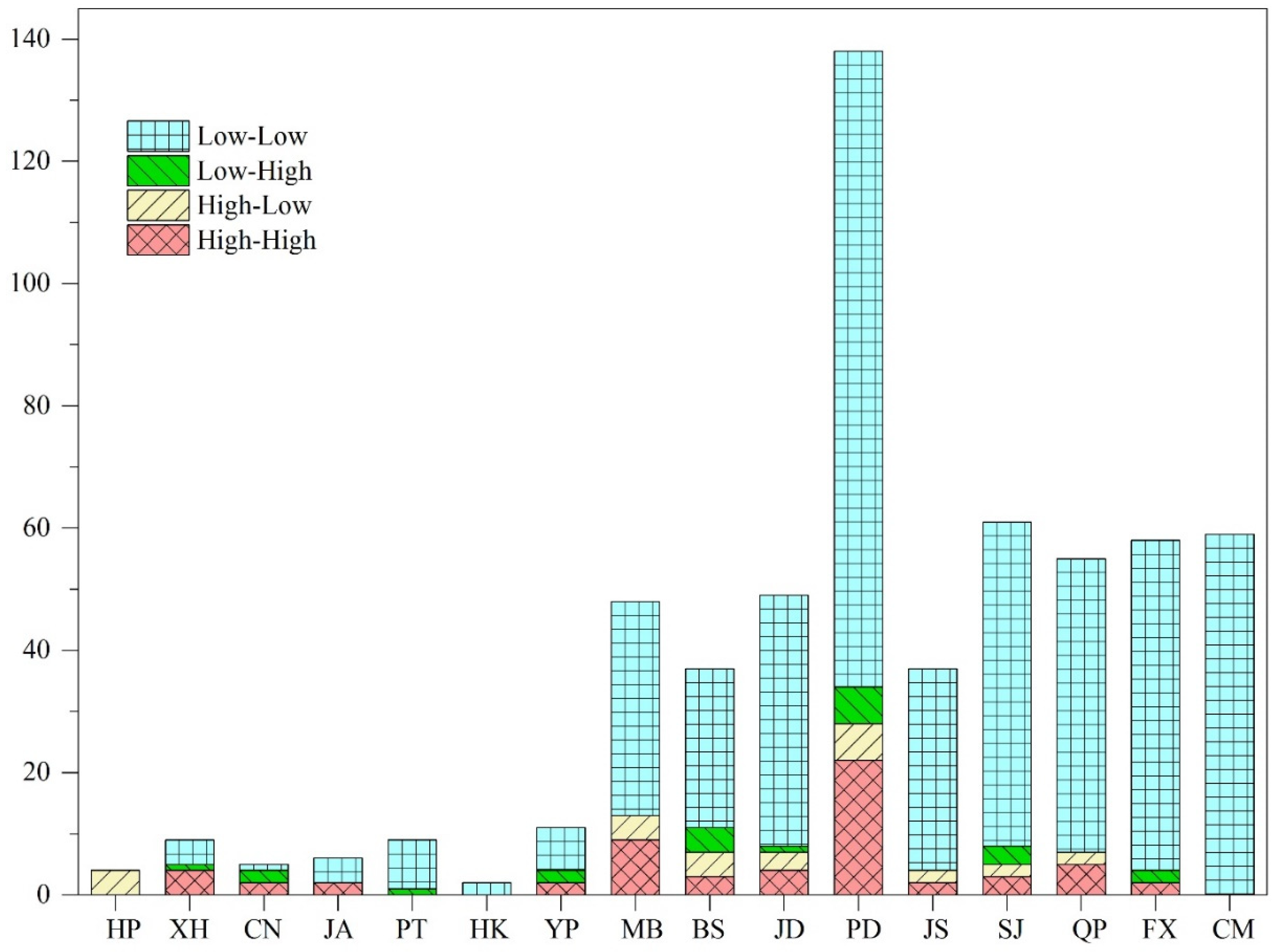Spatial Distribution Equilibrium and Relationship between Construction Land Expansion and Basic Education Schools in Shanghai Based on POI Data
Abstract
:1. Introduction
2. Materials and Methods
2.1. Study Area
2.2. Data Source and Processing
2.3. Method
2.3.1. Kernel Density Estimation (KDE)
2.3.2. Nearest Neighbor Indicator (NNI)
2.3.3. Ripley’s K-Function Analysis
2.3.4. Colocation Quotient Analysis (CLQ)
3. Results
3.1. Characteristics of the Spatial Distribution of Schools
3.2. Spatial Structure Distribution Equilibrium among School Types in Shanghai
3.3. Impact of the Cycle of Construction Land Growth on the Distribution of Schools
4. Conclusions and Discussion
Author Contributions
Funding
Institutional Review Board Statement
Informed Consent Statement
Data Availability Statement
Acknowledgments
Conflicts of Interest
References
- Norman, C. Francis quality education and equality of educational opportunity. NASSP Bull. 1977, 61, 16–25. [Google Scholar]
- Burger, K. The socio-spatial dimension of educational inequality: A comparative European analysis. Stud. Educ. Eval. 2019, 62, 171–186. [Google Scholar] [CrossRef] [Green Version]
- Hu, L.; He, S.; Luo, Y.; Su, S.; Xin, J.; Weng, M. A social-media-based approach to assessing the effectiveness of equitable housing policy in mitigating education accessibility induced social inequalities in Shanghai, China. Land Use Policy 2020, 94, 104513. [Google Scholar] [CrossRef]
- Dhar, P.; Ross, S.L. School district quality and property values: Examining differences along school district boundaries. J. Urban Econ. 2012, 71, 18–25. [Google Scholar] [CrossRef]
- Allen, R. Allocating pupils to their nearest secondary school: The consequences for social and ability stratification. Urban Stud. 2007, 44, 751–770. [Google Scholar] [CrossRef] [Green Version]
- Yuta, K. The effect of school quality on housing rents: Evidence from Matsue city in Japan. J. Jpn. Int. Econ. 2018, 50, 16–25. [Google Scholar]
- Wen, H.; Xiao, Y.; Zhang, L. School district, education quality, and housing price: Evidence from a natural experiment in Hangzhou, China. Cities 2017, 66, 72–80. [Google Scholar] [CrossRef]
- Organisation for Economic Cooperation and Development (OECD). Equity and Quality in Education: Supporting Disadvantaged Students and Schools; Organisation for Economic Cooperation and Development (OECD): Paris, France, 2012. [Google Scholar]
- Xiang, L.; Stillwell, J.; Burns, L.; Heppenstall, A.; Norman, P. A geodemographic classification of sub-districts to identify education inequality in Central Beijing. Comput. Environ. Urban Syst. 2018, 70, 59–70. [Google Scholar] [CrossRef]
- Wen, J.; Chudan, G.U. The rural-urban differences in resources allocation of basic education and its social consequence: Base on the analysis of China’s education statistics. J. East China Norm. Univ. Educ. Sci. 2017, 35, 33. [Google Scholar]
- Yang, J.; Huang, X.; Liu, X. An analysis of education inequality in China. Int. J. Educ. Dev. 2014, 37, 2–10. [Google Scholar] [CrossRef]
- Wei, Y.D. Spatiality of regional inequality. Appl. Geogr. 2015, 61, 1–10. [Google Scholar] [CrossRef]
- Liu, R.; Li, T.; Greene, R. Migration and inequality in rental housing: Affordability stress in the Chinese cities. Appl. Geogr. 2020, 115, 102138. [Google Scholar] [CrossRef]
- Qian, X.; Smyth, R. Measuring regional inequality of education in China: Widening coast–inland gap or widening rural–urban gap? J. Int. Dev. 2008, 20, 132–144. [Google Scholar] [CrossRef]
- Li, W. Education inequality in China: Problems of policies on access to higher education. J. Asian Public Policy 2008, 1, 115–123. [Google Scholar] [CrossRef]
- Rodríguez, C.; Amador, A.; Tarango, B.A. Mapping educational equity and reform policy in the borderlands: LatCrit spatial analysis of grade retention. Equity Excel. Educ. 2016, 49, 228–240. [Google Scholar] [CrossRef]
- Li, Z.; Luan, W.; Zhang, Z.; Su, M. Relationship between urban construction land expansion and population/economic growth in Liaoning Province, China. Land Use Policy 2020, 99, 105022. [Google Scholar] [CrossRef]
- Wu, Y.; Zhang, T.; Zhang, H.; Pan, T.; Ni, X.; Grydehøj, A.; Zhang, J. Factors influencing the ecological security of island cities: A neighborhood-scale study of Zhoushan Island, China. Sustain. Cities Soc. 2020, 55, 102029. [Google Scholar] [CrossRef]
- Wu, Y.; Zheng, X.; Sheng, L.; You, H. Exploring the equity and spatial evidence of educational facilities in Hangzhou, China. Soc. Indic. Res. 2020, 151, 1075–1096. [Google Scholar] [CrossRef]
- Tianbao, L.; Liwen, Z.; Du, P. Spatial characteristics and distribution pattern of the equilibrium level of municipal compulsory education resources —Take Dalian primary school as an example. Econ. Geogr. 2018, 7, 67–74. [Google Scholar]
- Tangqi, T.; Dongsheng, Y.; Jianglong, C. Evolution of compulsory educational facilities in urban Nanjing. Sci. Geogr. Sin. 2019, 3, 433–441. [Google Scholar]
- Hannum, E.; Liu, X.; Wang, F. Estimating the effects of educational system contraction: The case of China’s rural school closure initiative. Econ. Dev. Cult. Chang. 2021, 70, 485–528. [Google Scholar] [CrossRef]
- Howley, C.; Johnson, J.; Petrie, J. Consolidation of schools and districts: What the research says and what it means. Natl. Educ. Policy Cent. 2011. [Google Scholar]
- Chao, L. The impact of educational public goods allocation adjustment on human capital. Econ. Res. J. 2020, 55, 140–156. [Google Scholar]
- Wang, W. Decomposing inequality in compulsory education finance in China: 1998–2008. Public Finance Manag. 2014, 14, 437–458. [Google Scholar]
- Xie, T. Analysis on inter-provincial disparities of China’s rural education and convergence rate: Empirical analysis on 31 provinces’ (municipalities’) panel data from 2001 to 2008. Int. J. Educ. Manag. 2011, 25, 714–723. [Google Scholar] [CrossRef]
- Rao, J.; Ye, J. From a virtuous cycle of rural-urban education to urban-oriented rural basic education in China: An explanation of the failure of China’s Rural School Mapping Adjustment policy. J. Rural Stud. 2016, 47, 601–611. [Google Scholar] [CrossRef]
- Zhang, D.; Li, X.; Xue, J. Education inequality between rural and urban areas of the People’s Republic of China, migrants’ children education, and some implications. Asian Dev. Rev. 2015, 32, 196–224. [Google Scholar] [CrossRef]
- Liu, J.; Jacob, W.J. From access to quality: Migrant children’s education in urban China. Educ. Res. Policy Pract. 2013, 12, 177–191. [Google Scholar] [CrossRef]
- Pacione, M. The geography of educational disadvantage in Glasgow. Appl. Geogr. 1997, 17, 169–192. [Google Scholar] [CrossRef]
- Mulaku, G.; Nyadimo, E. GIS in education planning: The Kenyan school mapping project. Surv. Rev. 2011, 43, 567–578. [Google Scholar] [CrossRef]
- Yoon, E.S.; Lubienski, C. Thinking critically in space: Toward a mixed-methods geospatial approach to education policy analysis. Educ. Res. 2018, 47, 53–61. [Google Scholar] [CrossRef]
- Butler, T.; Robson, G. Social capital, gentrification and neighbourhood change in London: A comparison of three south London neighbourhoods. Urban Stud. 2001, 38, 2145–2162. [Google Scholar] [CrossRef]
- Thrupp, M. School admissions and the segregation of school intakes in New Zealand cities. Urban Stud. 2007, 44, 1393–1404. [Google Scholar] [CrossRef]
- Lubienski, C.; Lee, J. Geo-spatial analyses in education research: The critical challenge and methodological possibilities. Geogr. Res. J. Inst. Aust. Geogr. 2017, 55, 89–99. [Google Scholar] [CrossRef]
- Yong, W.; Change, L.U.; Education, S.O. Analysis on the regional proportionality of preschool educational resources allocation: With the technical supporting of GIS. J. Mianyang Teach. Coll. 2018, 37, 27–32. [Google Scholar]
- Xie, C.D.; University, Y.Z.N. Analysis on the equilibrium degree of regional allocation of educational resources in weaker schools of compulsory education. J. Nanchang Coll. Educ. 2019. [Google Scholar]
- Yuan, Z.; Qian, J.; Zhu, H. The Xinjiang class: Multi-ethnic encounters in an eastern coastal city. China Q. 2017, 232, 1094–1115. [Google Scholar] [CrossRef] [Green Version]
- Glorius, B. Transnational social capital in migration: The example of educational migration between Bulgaria and Germany. Soc. Incl. 2019, 7, 232–242. [Google Scholar] [CrossRef]
- Liu, K.; Yin, L.; Lu, F.; Mou, N. Visualizing and exploring POI configurations of urban regions on POI-type semantic space. Cities 2020, 99, 102610. [Google Scholar] [CrossRef]
- Lan, T.; Yu, M.; Xu, Z.; Wu, Y. Temporal and spatial variation characteristics of catering facilities based on POI data: A case study within 5th ring road in Beijing. Procedia Comput. Sci. 2018, 131, 1260–1268. [Google Scholar] [CrossRef]
- Zhai, W.; Bai, X.; Shi, Y.; Han, Y.; Peng, Z.-R.; Gu, C. Beyond Word2vec: An approach for urban functional region extraction and identification by combining Place2vec and POIs. Comput. Environ. Urban Syst. 2019, 74, 1–12. [Google Scholar] [CrossRef]
- He, Q.; He, W.; Song, Y.; Wu, J.; Yin, C.; Mou, Y. The impact of urban growth patterns on urban vitality in newly built-up areas based on an association rules analysis using geographical ‘big data’. Land Use Policy 2018, 78, 726–738. [Google Scholar] [CrossRef]
- Yang, J.; Ren, J.; Sun, D.; Xiao, X.; Xia, J.; Jin, C.; Li, X. Understanding land surface temperature impact factors based on local climate zones. Sustain. Cities Soc. 2021, 69, 102818. [Google Scholar] [CrossRef]
- Zeng, J.; Yuanyuan, Y.E.; Zhong, Z. Research into the equalization of public service formats based on POI big data. J. West Anhui Univ. 2018, 34, 72–75. [Google Scholar]
- Su, F.; Mo, X.; Min, W.; Li, B. The equalization of the general high school education and its obstacle factors in China. Sci. Geogr. Sin. 2017, 10, 1478–1485. [Google Scholar]
- Zhao, C.; Shao, J.A.; Guo, Y.; Xu, X. Spatial pattern evolvement characteristics of rural schools and their development level in the mountainous area. Geogr. Res. 2016, 35, 455–470. [Google Scholar]
- Development of National Education in 2019. Available online: www.moe.gov.cn/jyb_sjzl/s5990/202008/t20200831_483697.html (accessed on 3 October 2019).
- Yang, J.; Xie, P.; Xi, J.; Ge, Q.; Ma, Z. LUCC simulation based on the cellular automata simulation: A case study of Dalian Economic and Technological Development Zone. Acta Geogr. Sin. 2015, 70, 461–475. [Google Scholar]
- Yang, J.; Wang, Y.; Xue, B.; Li, Y.; Xiaog, X.; Xia, J.; He, B. Contribution of urban ventilation to the thermal environment and urban energy demand: Different climate background perspectives. Sci. Total Environ. 2021, 795, 148791. [Google Scholar] [CrossRef]
- Luo, X.; Yang, J.; Sun, W.; He, B. Suitability of human settlements in mountainous areas from the perspective of ventilation: A case study of the main urban area of Chongqing. J. Clean. Prod. 2021, 310, 127467. [Google Scholar] [CrossRef]
- Dong, L.; Li, J.; Xu, Y.; Yang, Y.; Li, X.; Zhang, H. Study on the spatial classification of construction land types in Chinese cities: A case study in Zhejiang province. Land 2021, 10, 523. [Google Scholar] [CrossRef]
- Yang, J.; Guo, A.; Li, Y.; Zhang, Y.; Li, X. Simulation of landscape spatial layout evolution in rural-urban fringe areas: A case study of Ganjingzi District. GIScience Remote Sens. 2019, 56, 388–405. [Google Scholar] [CrossRef]
- Zhu, J.; Li, B.; He, B.-J. Is linked migration overlooked in peri-urban Shanghai? Uncovering the domino effect of driving away interregional migrants. Habitat Int. 2019, 94, 102046. [Google Scholar] [CrossRef]
- Silverman, B.W. Density Estimation for Statistics and Data Analysis; Routledge: Abingdon, UK, 1986. [Google Scholar]
- Xue, B.; Xiao, X.; Li, J. Identification method and empirical study of urban industrial spatial relationship based on POI big data: A case of Shenyang City, China. Geogr. Sustain. 2020, 1, 152–162. [Google Scholar] [CrossRef]
- Shen, Q.X.; Li, C.G.; Liu, Z.Y. Spatial pattern of public service facilities space and living space in Changchun. Geogr. Res. 2018, 37, 127–136. [Google Scholar]
- Hao, F.; Shi, X.; Xue, B.; Wang, S. Geographic detection and multifunctional land use from the perspective of urban diversity: A case study of Changchun. Geogr. Res. 2019, 38, 247–258. [Google Scholar]
- Leslie, T.F.; Kronenfeld, B.J. The colocation quotient: A new measure of spatial association between categorical subsets of points. Geogr. Anal. 2011, 43, 306–326. [Google Scholar] [CrossRef]
- Yang, J.; Yang, Y.; Sun, D.; Jin, C.; Xiao, X. Influence of urban morphological characteristics on thermal environment. Sustain. Cities Soc. 2021, 72, 103045. [Google Scholar] [CrossRef]
- Lin, J.; Huang, B.; Chen, M.; Huang, Z. Modeling urban vertical growth using cellular automata—Guangzhou as a case study. Appl. Geogr. 2014, 53, 172–186. [Google Scholar] [CrossRef]
- Li, C.; Wu, K.; Gao, X. Manufacturing industry agglomeration and spatial clustering: Evidence from Hebei Province, China. Environ. Dev. Sustain. 2020, 22, 2941–2965. [Google Scholar] [CrossRef]
- Haepp, T.; Lyu, L. The impact of primary school investment reallocation on educational attainment in rural China. J. Asia Pac. Econ. 2018, 23, 606–627. [Google Scholar] [CrossRef]
- Zhao, Z.Q.; He, B.J.; Li, L.G.; Wang, H.B.; Darko, A. Profile and concentric zonal analysis of relationships between land use/land cover and land surface temperature: Case study of Shenyang, China. Energy Build. 2017, 155, 282–295. [Google Scholar]
- Sherman, J.D.; Poirier, J.M. Educational Equity and Public Policy: Comparing Results From 16 Countries; UNESCO Institute for Statistics: Montreal, QC, Canada, 2007. [Google Scholar]
- Malczewski, J.; Jackson, M. Multicriteria spatial allocation of educational resources: An overview. Socio-Econ. Plan. Sci. 2000, 34, 219–235. [Google Scholar] [CrossRef]
- Peng, Y.; Wang, Z. Space operation of rural primary and secondary school location. Acta Geogr. Sin. 2013, 68, 1411–1417. [Google Scholar]
- Li, C.; Gao, X.; Wu, J.; Wu, K. Demand prediction and regulation zoning of urban-industrial land: Evidence from Beijing-Tianjin-Hebei Urban Agglomeration, China. Environ. Monit. Assess. 2019, 191, 412. [Google Scholar] [CrossRef] [PubMed]
- He, B.J.; Zhao, Z.Q.; Shen, L.D.; Wang, H.B.; Li, L.G. An approach to examining performances of cool/hot sources in mitigating/enhancing land surface temperature under different temperature backgrounds based on Landsat 8 image. Sustain. Cities Soc. 2018, 44, 416–427. [Google Scholar] [CrossRef]







| Type | Kindergarten | Elementary School | Junior High School |
|---|---|---|---|
| NNI | 0.515 | 0.631 | 0.69 |
| z | −42.771 | −21.645 | −13.552 |
| P | <0.01 | <0.01 | <0.01 |
| Proximity | Number of Coverage | Colocation Quotient |
|---|---|---|
| kindergarten → elementary school | 1723 | 2.31 |
| elementary school → junior high school | 626 | 1.85 |
| elementary school → kindergarten | 2120 | 0.81 |
| junior high school → elementary school | 944 | 0.63 |
| Level | Rationale for Classification | Number |
|---|---|---|
| High-High | Junior high school existed, and the proportions in elementary school and kindergarten were higher than the average proportion in Shanghai | 60 |
| High-Low | Junior high school existed, elementary school was higher than the average proportion in Shanghai, and kindergartens were lower than the average proportion in Shanghai | 27 |
| Low-High | Junior high school existed, elementary school was lower than the average proportion in Shanghai, and kindergartens were higher than the average proportion in Shanghai | 22 |
| Low-Low | Junior high school, elementary school, kindergartens were lower than the average proportion in Shanghai | 480 |
| Growth Cycle | Junior High School | Elementary School | Kindergarten | Constructed Land Area (km2) | Density (Unit/km2) |
|---|---|---|---|---|---|
| 30 Year | 261 | 482 | 964 | 556.26 | 3.06 |
| 20 Year | 317 | 575 | 1211 | 777.87 | 2.71 |
| 10 Year | 347 | 618 | 1343 | 1053.63 | 2.33 |
| Less Than 10 Year | 429 | 775 | 1774 | 2031.63 | 1.47 |
Publisher’s Note: MDPI stays neutral with regard to jurisdictional claims in published maps and institutional affiliations. |
© 2021 by the authors. Licensee MDPI, Basel, Switzerland. This article is an open access article distributed under the terms and conditions of the Creative Commons Attribution (CC BY) license (https://creativecommons.org/licenses/by/4.0/).
Share and Cite
Zhang, Z.; Luan, W.; Tian, C.; Su, M.; Li, Z. Spatial Distribution Equilibrium and Relationship between Construction Land Expansion and Basic Education Schools in Shanghai Based on POI Data. Land 2021, 10, 1059. https://doi.org/10.3390/land10101059
Zhang Z, Luan W, Tian C, Su M, Li Z. Spatial Distribution Equilibrium and Relationship between Construction Land Expansion and Basic Education Schools in Shanghai Based on POI Data. Land. 2021; 10(10):1059. https://doi.org/10.3390/land10101059
Chicago/Turabian StyleZhang, Zhenchao, Weixin Luan, Chuang Tian, Min Su, and Zeyang Li. 2021. "Spatial Distribution Equilibrium and Relationship between Construction Land Expansion and Basic Education Schools in Shanghai Based on POI Data" Land 10, no. 10: 1059. https://doi.org/10.3390/land10101059
APA StyleZhang, Z., Luan, W., Tian, C., Su, M., & Li, Z. (2021). Spatial Distribution Equilibrium and Relationship between Construction Land Expansion and Basic Education Schools in Shanghai Based on POI Data. Land, 10(10), 1059. https://doi.org/10.3390/land10101059







